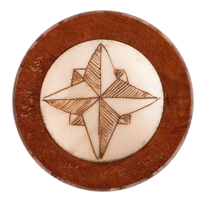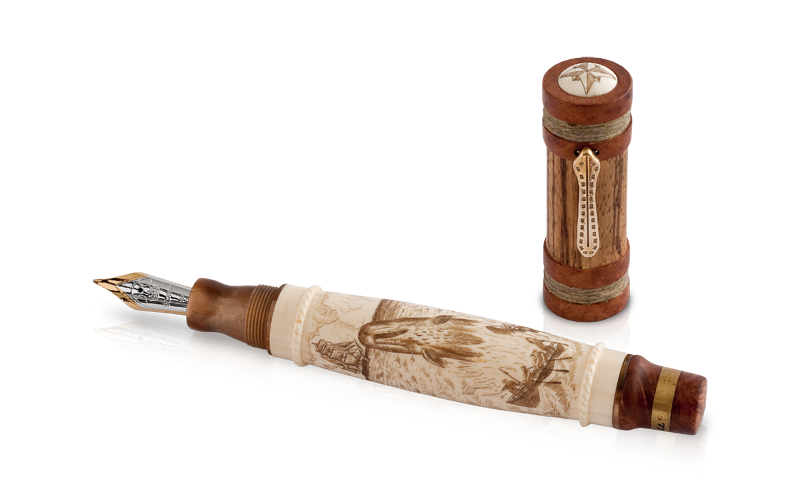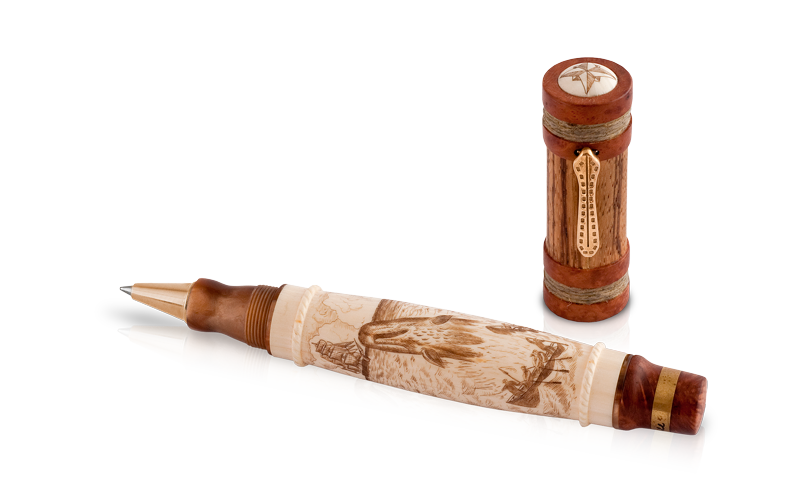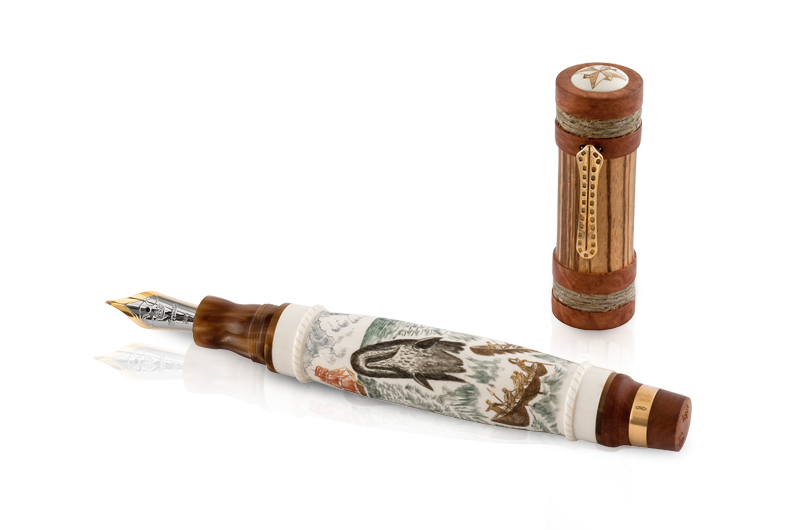“Call me Ishmael.”
So begins Herman Melville’s epic novel Moby Dick. Completed in 1850, it drew heavily on Melville’s experiences as a young man when he spent four years at sea on whaling ship as a common sailor. The book is rich in details about the operation of a New England whaling vessel, but also tackles the large theme of searching for meaning in the existential void symbolized by the ocean. Furthermore, the hunt for the great white whale serves as a metaphor for man’s search for meaning in a world rife with deception and delusion.
Ishmael serves as the book’s narrator and comes aboard the Pequod as a common sailor who has no ties to the land and had disavowed all privilege based on skin color or money. He chooses to associate with the meanest sailors on the earth’s oceans. Ishmael is interested in exploring the sea and views the white whale, Moby Dick, as a mystery to be pursued and studied. This view stands in stark contrast to Captain Ahab, whose purpose in the Pequod’s voyage is simple revenge. He lost a leg to the white whale and is intent on killing the beast. His rigid obsession ultimately dooms the ship and its crew. When the Pequod is sunk during its cataclysmic battle with Moby Dick, Ishmael is the lone survivor, the one who lives to tell the harrowing tale.
Moby Dick, or The Whale was officially published in New York on November 1, 1851. Harper’s had 2915 copies printed for the first run and the retail price was $1.50. The book was dedicated to Melville’s great friend, Nathanial Hawthorne and inscribed as follows: In token of my admiration for his genius, this book is inscribed to Nathanial Hawthorne.
In its time Moby Dick was not a commercial success. After a series of mediocre reviews it sold only 1500 copies in its first month on the stands, 2300 copies in the next year and 5500 over the next half- century. Melville’s lifetime earnings from one of the acknowledged masterworks of the English language totaled $1260. However, the decades have been kind to Melville and to Moby Dick and today it is recognized as a work of genius, far ahead of its time in terms of themes and the multi-layered nature of the narrative. It compares favorably to some of the world’s most powerful books. All from the pen of a young man who had barely attended school past the 12th grade and became the most formidable writer of his time.
SPECIFICATIONS
Krone honors the writing of Herman Melville’s Moby Dick with a stunning writing instrument. The barrel is Mammoth Ivory, which is at least 10,000 years old. The rich, delicate, sepia-colored scrimshaw artwork is a portrait of Herman Melville as well as a scene from the Moby Dick story.
 The cap is made with African Zebra wood panels framed by Briarwood. Trimming the top and bottom of the cap there are hand-wrapped insets of antiqued twine, simulating a ship’s rigging. On the top of the cap, set into the Briarwood, is a Mammoth Ivory disk with a Compass Rose done in scrimshaw. The blind cap has a bronze band with Herman Melville’s signature deeply engraved.
The cap is made with African Zebra wood panels framed by Briarwood. Trimming the top and bottom of the cap there are hand-wrapped insets of antiqued twine, simulating a ship’s rigging. On the top of the cap, set into the Briarwood, is a Mammoth Ivory disk with a Compass Rose done in scrimshaw. The blind cap has a bronze band with Herman Melville’s signature deeply engraved.
A Limited Edition of 288 Fountain Pens and 38 Rollerballs worldwide. This pen is also available in an 18 piece edition where the barrel has multi-colored scrimshaw and all accents are rose gold. Piston Fill. F, M and B.
“Call me Ishmael.”
So begins Herman Melville’s epic novel Moby Dick. Completed in 1850, it drew heavily on Melville’s experiences as a young man when he spent four years at sea on whaling ship as a common sailor. The book is rich in details about the operation of a New England whaling vessel, but also tackles the large theme of searching for meaning in the existential void symbolized by the ocean. Furthermore, the hunt for the great white whale serves as a metaphor for man’s search for meaning in a world rife with deception and delusion.
Ishmael serves as the book’s narrator and comes aboard the Pequod as a common sailor who has no ties to the land and had disavowed all privilege based on skin color or money. He chooses to associate with the meanest sailors on the earth’s oceans. Ishmael is interested in exploring the sea and views the white whale, Moby Dick, as a mystery to be pursued and studied. This view stands in stark contrast to Captain Ahab, whose purpose in the Pequod’s voyage is simple revenge. He lost a leg to the white whale and is intent on killing the beast. His rigid obsession ultimately dooms the ship and its crew. When the Pequod is sunk during its cataclysmic battle with Moby Dick, Ishmael is the lone survivor, the one who lives to tell the harrowing tale.
Moby Dick, or The Whale was officially published in New York on November 1, 1851. Harper’s had 2915 copies printed for the first run and the retail price was $1.50. The book was dedicated to Melville’s great friend, Nathanial Hawthorne and inscribed as follows: In token of my admiration for his genius, this book is inscribed to Nathanial Hawthorne.
In its time Moby Dick was not a commercial success. After a series of mediocre reviews it sold only 1500 copies in its first month on the stands, 2300 copies in the next year and 5500 over the next half- century. Melville’s lifetime earnings from one of the acknowledged masterworks of the English language totaled $1260. However, the decades have been kind to Melville and to Moby Dick and today it is recognized as a work of genius, far ahead of its time in terms of themes and the multi-layered nature of the narrative. It compares favorably to some of the world’s most powerful books. All from the pen of a young man who had barely attended school past the 12th grade and became the most formidable writer of his time.
SPECIFICATIONS
Krone honors the writing of Herman Melville’s Moby Dick with a stunning writing instrument. The barrel is Mammoth Ivory, which is at least 10,000 years old. The rich, delicate, sepia-colored scrimshaw artwork is a portrait of Herman Melville as well as a scene from the Moby Dick story.
 The cap is made with African Zebra wood panels framed by Briarwood. Trimming the top and bottom of the cap there are hand-wrapped insets of antiqued twine, simulating a ship’s rigging. On the top of the cap, set into the Briarwood, is a Mammoth Ivory disk with a Compass Rose done in scrimshaw. The blind cap has a bronze band with Herman Melville’s signature deeply engraved.
The cap is made with African Zebra wood panels framed by Briarwood. Trimming the top and bottom of the cap there are hand-wrapped insets of antiqued twine, simulating a ship’s rigging. On the top of the cap, set into the Briarwood, is a Mammoth Ivory disk with a Compass Rose done in scrimshaw. The blind cap has a bronze band with Herman Melville’s signature deeply engraved.
A Limited Edition of 288 Fountain Pens and 38 Rollerballs worldwide. This pen is also available in an 18 piece edition where the barrel has multi-colored scrimshaw and all accents are rose gold. Piston Fill.
F, M and B.
“Call me Ishmael.”
So begins Herman Melville’s epic novel Moby Dick. Completed in 1850, it drew heavily on Melville’s experiences as a young man when he spent four years at sea on whaling ship as a common sailor. The book is rich in details about the operation of a New England whaling vessel, but also tackles the large theme of searching for meaning in the existential void symbolized by the ocean. Furthermore, the hunt for the great white whale serves as a metaphor for man’s search for meaning in a world rife with deception and delusion.
Ishmael serves as the book’s narrator and comes aboard the Pequod as a common sailor who has no ties to the land and had disavowed all privilege based on skin color or money. He chooses to associate with the meanest sailors on the earth’s oceans. Ishmael is interested in exploring the sea and views the white whale, Moby Dick, as a mystery to be pursued and studied. This view stands in stark contrast to Captain Ahab, whose purpose in the Pequod’s voyage is simple revenge. He lost a leg to the white whale and is intent on killing the beast. His rigid obsession ultimately dooms the ship and its crew. When the Pequod is sunk during its cataclysmic battle with Moby Dick, Ishmael is the lone survivor, the one who lives to tell the harrowing tale.Moby Dick, or The Whale was officially published in New York on November 1, 1851. Harper’s had 2915 copies printed for the first run and the retail price was $1.50. The book was dedicated to Melville’s great friend, Nathanial Hawthorne and inscribed as follows: In token of my admiration for his genius, this book is inscribed to Nathanial Hawthorne.
In its time Moby Dick was not a commercial success. After a series of mediocre reviews it sold only 1500 copies in its first month on the stands, 2300 copies in the next year and 5500 over the next half- century. Melville’s lifetime earnings from one of the acknowledged masterworks of the English language totaled $1260. However, the decades have been kind to Melville and to Moby Dick and today it is recognized as a work of genius, far ahead of its time in terms of themes and the multi-layered nature of the narrative. It compares favorably to some of the world’s most powerful books. All from the pen of a young man who had barely attended school past the 12th grade and became the most formidable writer of his time.
SPECIFICATIONS
Krone honors the writing of Herman Melville’s Moby Dick with a stunning writing instrument. The barrel is Mammoth Ivory, which is at least 10,000 years old. The rich, delicate, sepia-colored scrimshaw artwork is a portrait of Herman Melville as well as a scene from the Moby Dick story.
 The cap is made with African Zebra wood panels framed by Briarwood. Trimming the top and bottom of the cap there are hand-wrapped insets of antiqued twine, simulating a ship’s rigging. On the top of the cap, set into the Briarwood, is a Mammoth Ivory disk with a Compass Rose done in scrimshaw. The blind cap has a bronze band with Herman Melville’s signature deeply engraved.
The cap is made with African Zebra wood panels framed by Briarwood. Trimming the top and bottom of the cap there are hand-wrapped insets of antiqued twine, simulating a ship’s rigging. On the top of the cap, set into the Briarwood, is a Mammoth Ivory disk with a Compass Rose done in scrimshaw. The blind cap has a bronze band with Herman Melville’s signature deeply engraved.
A Limited Edition of 288 Fountain Pens and 38 Rollerballs worldwide. This pen is also available in an 18 piece edition where the barrel has multi-colored scrimshaw and all accents are rose gold. Piston Fill.
F, M and B.
 The cap is made with African Zebra wood panels framed by Briarwood. Trimming the top and bottom of the cap there are hand-wrapped insets of antiqued twine, simulating a ship’s rigging. On the top of the cap, set into the Briarwood, is a Mammoth Ivory disk with a Compass Rose done in scrimshaw. The blind cap has a bronze band with Herman Melville’s signature deeply engraved.
The cap is made with African Zebra wood panels framed by Briarwood. Trimming the top and bottom of the cap there are hand-wrapped insets of antiqued twine, simulating a ship’s rigging. On the top of the cap, set into the Briarwood, is a Mammoth Ivory disk with a Compass Rose done in scrimshaw. The blind cap has a bronze band with Herman Melville’s signature deeply engraved. The cap is made with African Zebra wood panels framed by Briarwood. Trimming the top and bottom of the cap there are hand-wrapped insets of antiqued twine, simulating a ship’s rigging. On the top of the cap, set into the Briarwood, is a Mammoth Ivory disk with a Compass Rose done in scrimshaw. The blind cap has a bronze band with Herman Melville’s signature deeply engraved.
The cap is made with African Zebra wood panels framed by Briarwood. Trimming the top and bottom of the cap there are hand-wrapped insets of antiqued twine, simulating a ship’s rigging. On the top of the cap, set into the Briarwood, is a Mammoth Ivory disk with a Compass Rose done in scrimshaw. The blind cap has a bronze band with Herman Melville’s signature deeply engraved. The cap is made with African Zebra wood panels framed by Briarwood. Trimming the top and bottom of the cap there are hand-wrapped insets of antiqued twine, simulating a ship’s rigging. On the top of the cap, set into the Briarwood, is a Mammoth Ivory disk with a Compass Rose done in scrimshaw. The blind cap has a bronze band with Herman Melville’s signature deeply engraved.
The cap is made with African Zebra wood panels framed by Briarwood. Trimming the top and bottom of the cap there are hand-wrapped insets of antiqued twine, simulating a ship’s rigging. On the top of the cap, set into the Briarwood, is a Mammoth Ivory disk with a Compass Rose done in scrimshaw. The blind cap has a bronze band with Herman Melville’s signature deeply engraved.


